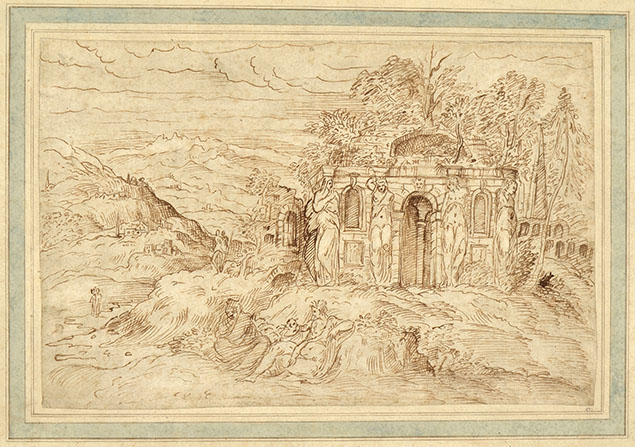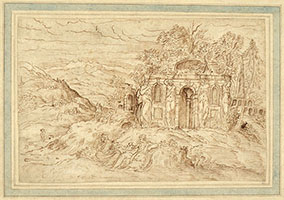(VICENZA 1520 – 1583)
LANDSCAPE WITH RUINS OF A TEMPLE WITH CARYATIDS
Pen and brown ink on laid paper, laid down
211 x 321 mm
This drawing is a version of Pittoni’s drawing in Stockholm’s Nationalmuseum (inv. no. NMH 1375/1863) used in preparation for an etching, which reverses both drawings. The etching was first formally published by Francesco Ziletti in 1585 as part of a series of 20 prints entitled Imagini favolose, nelle quali in diversi modi si vengono rappresentate le più vaghe favole de gli antichi da M. Batista Pittoni, though the prints were already circulating among artists such as Paolo Veronese in the 1560s. As noted in the 1988 auction catalogue, the drawing is by the same draughtsman as the Pittoni drawing in the Metropolitan Museum (acc. no. 1975.131.1)
Provenance:
-William Sharp (Lugt 2650), his mark on verso of mount, in lower left corner. Inscription on center of the verso of mount reads: “N.B. His Drawing has been etched by the Artist/the same size, but in the reverse direction and marked B.P./I have an impression W.S.” -London, Sotheby’s, 27 January 1966, lot 157 (as Venetian School, 17th century); sold to Horner
-Paul Mathias Polakovits (Lugt 3561), his mark on recto of mount, in lower right corner -Paris, Hôtel Drouot, Auctioneers: J.P. Couturier, R. de Nicolay, B. de Bayser (expert), Dessins anciens de la Collection Mathias Polakovits, 4 March 1988, lot 225 (as PITTONI Giovanni Battista le vieux dit “Vicentino”)
-Florence, Gonnelli Casa d'Aste, 16 October 2011, lot 132 (as Pittoni Giovanni Battista il Vecchio «Detto Battista Vicentino»)
Bibliography:
-Per Bjurström. Italian drawings. Venice, Brescia, Parma, Milan, Genoa. Nationalmuseum Stockholm, 1979. Cat. no. 106, (as version of Stockholm preparatory drawing for the etching).
-Emmanuelle Brugerolles and David Guillet. Les dessins vénitiens des collections de l'École des Beaux-Arts. ENSBA Paris, 1990. Note for cat. no. 22, p. 46. (as copy of Stockholm preparatory drawing for the etching).
-Barbara Maria Savy. “«Cinquanta carte di paesi varij, e belli» Battista Pittoni, Battista del Moro e le antichità di Roma di Hieronymus Cock.” Il paesaggio veneto nel rinascimento europeo. Milan, 2019, p. 160 and footnote 47 (as version of Stockholm preparatory drawing for the etching).
Italian printmaker and miniaturist, Pittoni is known for his etched views of ancient ruins and extensive landscapes as well as ornamental prints that date mostly to the 1560s. These include a 1561 edition copying Hieronymus Cock’s Praecipua aliquot Romanae antiquitatis ruinarum monimenta (1551), the Imprese of 1562 that comprises emblems or devices for noble or noteworthy individuals and included verses by the literary figure Lodovico Dolce, and a further Imprese of 1566. Another etched series, which is undated, figures imaginary ancient ruins and sometimes incorporates mythological subjects. Paolo Veronese made use of two Pittoni etchings for his frescoes in Villa Barbaro at Maser, which were completed in the early 1560s. The series was later published in 1585, after Pittoni’s death, and the later prints may be distinguished by their B.P. monogram within the plates.
Vasari writes of Pittoni within the chapter on Marcantonio Raimondi in his 1568 edition of the Vite as follows: “Dopo costoro ha fatto cinquanta carte di paesi varij, e belli Batista pittore vicentino, e Battista del Moro veronese; et in Fiandra ha fatto Ieronimo Coca l’Arti liberali...” [After these people, fifty prints of various beautiful villages were made by the painter Battista from Vicenza, and Battista del Moro from Verona; and in Flanders Hieronymus Cock created the Liberal Arts...]. Barbara Maria Savy in 2019 published a lengthy essay addressing Vasari’s mention of Battista Pittoni and Battista del Moro, and she convincingly disentangles the works of these two artists.


